Moon Phases, Eclipses, Seasons: An Astronomy Primer
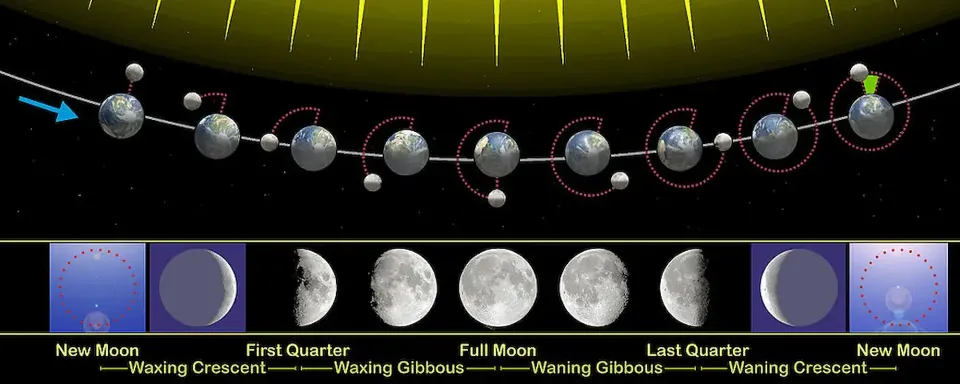
TL;DR: Seasons happen because Earth’s 23.5° tilt; Moon phases are just our changing view of its sunlit half; eclipses occur only when Sun–Earth–Moon align at the lunar nodes.
If you’ve ever stared at a model of the solar system and wondered why it looks like a cosmic fried egg, or asked why we don’t get eclipses every month, or why your horoscope constellation isn’t even in the night sky on your birthday, you’re in the right place. Here’s what’s really going on above your head.
Curious what actually counts as good evidence? A Quick Note About Evidence.
The Structure of the Solar System (and Where Comets Come From)
Our solar system is organized, but not quite as tidy as a science fair diorama. The basics:
Rocky Planets: Mercury, Venus, Earth, Mars. Small, dense, close to the Sun.
Asteroid Belt: Between Mars and Jupiter—a debris field of rocky leftovers.
Gas Giants: Jupiter and Saturn (plus Uranus and Neptune, “ice giants” technically, but equally chilly).
Kuiper Belt: Beyond Neptune, home to Pluto and a mess of icy bodies.
Dwarf Planets: (currently only five discovered, but probably many more exist) Ceres, Pluto, Haumea, Makemake, and Eris.
Heliosphere: The “bubble” blown by solar wind that marks the Sun’s influence.
Oort Cloud: A vast, distant, hypothetical shell of icy debris surrounding the solar system—so far away, we haven’t seen it directly. Most long-period comets are thought to originate here, nudged by passing stars or the gravity of the galaxy itself before falling into the inner solar system in dramatic fashion.
The Ecliptic Plane: The Solar System’s Grand Disk
When you see a solar system model that looks like a fried egg—with the Sun as the yolk and planets orbiting in flat rings—you’re looking at the ecliptic plane. This is the imaginary flat surface defined by Earth’s orbit around the Sun, but it’s roughly the same for all the major planets (with only minor tilts).
The reason for this alignment? The solar system formed from a spinning disk of gas and dust. Most of the material (and thus, the orbits) ended up flattened into this plane, rather than flying around at random angles.
Crash Course Astronomy: Orbits
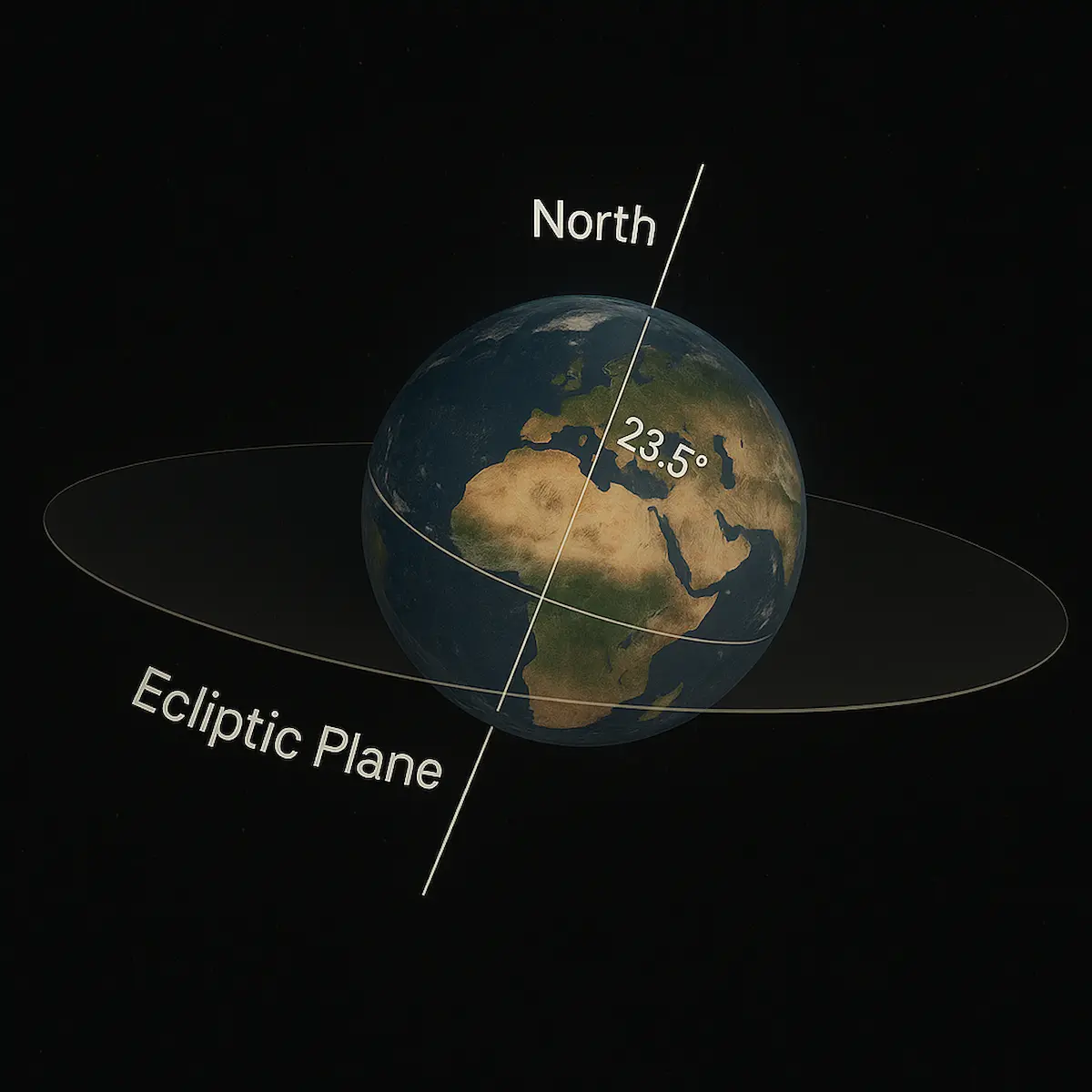
Prefer clean tests for claims? Russell’s Teapot is a quick primer on burden of proof.
Earth’s Tilt: Not Upright in its Seat
When we say the Earth is “tilted on its axis,” we mean it spins at an angle—23.5 degrees off vertical—relative to the ecliptic plane. Picture a spinning top leaning slightly as it spins, not straight up and down.
Analogy:
If the ecliptic is a dinner plate sitting flat on a table, Earth is a spinning egg, leaning to the side instead of sitting upright in your egg cup. The tilt determines how sunlight hits different parts of the globe throughout the year.
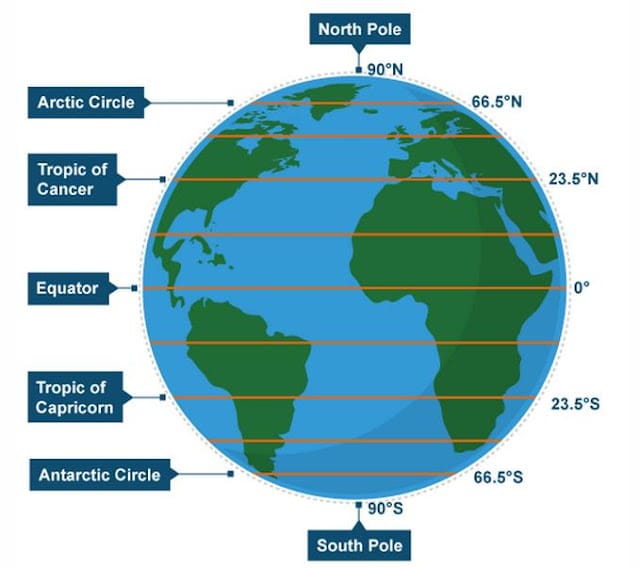
Latitude, Longitude, and Hemispheres: The Global Grid
Latitude, Longitude, and Hemispheres: The Global Grid
Latitude lines run east–west around the Earth and measure distance north or south of the Equator (0° latitude). They are parallel to each other and are calculated as the angle between the equator, the center of the Earth, and a point on the surface. Key latitudes include:
- Equator (0°) – Divides the Earth into the Northern and Southern Hemispheres.
- Tropic of Cancer (≈23.5° N) – Northernmost point where the Sun can be directly overhead, at the June solstice.
- Tropic of Capricorn (≈23.5° S) – Southernmost point where the Sun can be directly overhead, at the December solstice.
- Arctic Circle (≈66.5° N) – Southern limit of at least one 24-hour period of daylight or darkness each year.
- Antarctic Circle (≈66.5° S) – Northern limit of at least one 24-hour period of daylight or darkness each year.
- North Pole (90° N) and South Pole (90° S) – Points where Earth’s rotation axis meets its surface.
Longitude lines run from pole to pole and measure distance east or west of the Prime Meridian (0° longitude), which passes through Greenwich, England. Longitude is calculated as the angle east or west between the Prime Meridian, the center of the Earth, and a point on the surface. The line directly opposite the Prime Meridian is the 180th meridian, which, along with the Prime Meridian, divides the Earth into the Eastern and Western Hemispheres and roughly follows the International Date Line.
Hemispheres:
- Northern / Southern – Divided by the Equator.
- Eastern / Western – Divided by the Prime Meridian and the 180th meridian.
Seasons: Not Just Hot and Cold
Seasons happen because of the Earth’s tilt relative to the ecliptic. When your hemisphere is tilted toward the Sun, you get longer days and more direct sunlight—summer. Tilted away? Shorter days and weaker sunlight—winter.
Shoulder seasons: Spring and autumn (fall) are when the tilt is sideways to the Sun, so both hemispheres get roughly equal light and temperatures are moderate.
Tilt and the tropics: Near the equator (between the tropics), the Sun is never far from overhead, so seasons are less dramatic—often just “wet” and “dry.”
High latitudes: Near the poles, the Sun swings wildly above and below the horizon, giving you endless daylight or endless night.
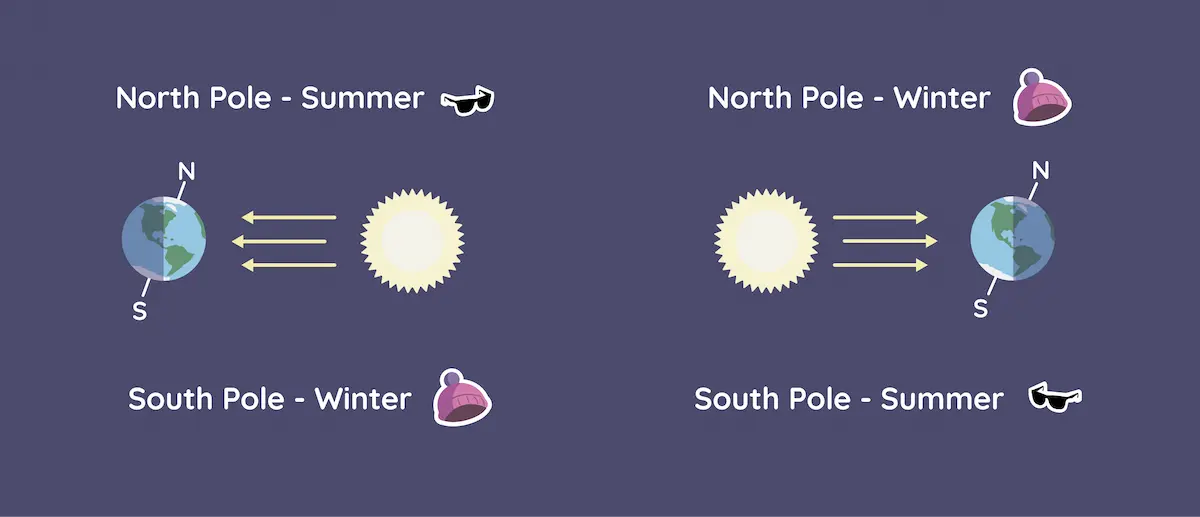
For another step-by-step look at how science explains patterns in nature, see How the Eye Evolved.
Eclipses: Cosmic Coincidences and Why They’re Rare
Solar and Lunar Eclipses
Solar Eclipse: The Moon passes between Earth and the Sun. If you’re in the narrow path of the shadow (the “umbra”), you see a total eclipse.
Lunar Eclipse: Earth passes between the Sun and the Moon, shadowing the Moon.
Why Most Eclipses Aren’t Total
The Moon’s orbit is tilted about 5 degrees to the ecliptic plane. Imagine two dinner plates, one stacked slightly off-kilter atop the other—the ecliptic (Earth’s path) and the Moon’s path. Most of the time, the Moon passes above or below the Sun from our view, so the shadows don’t align perfectly, which is why most eclipses are only partial.
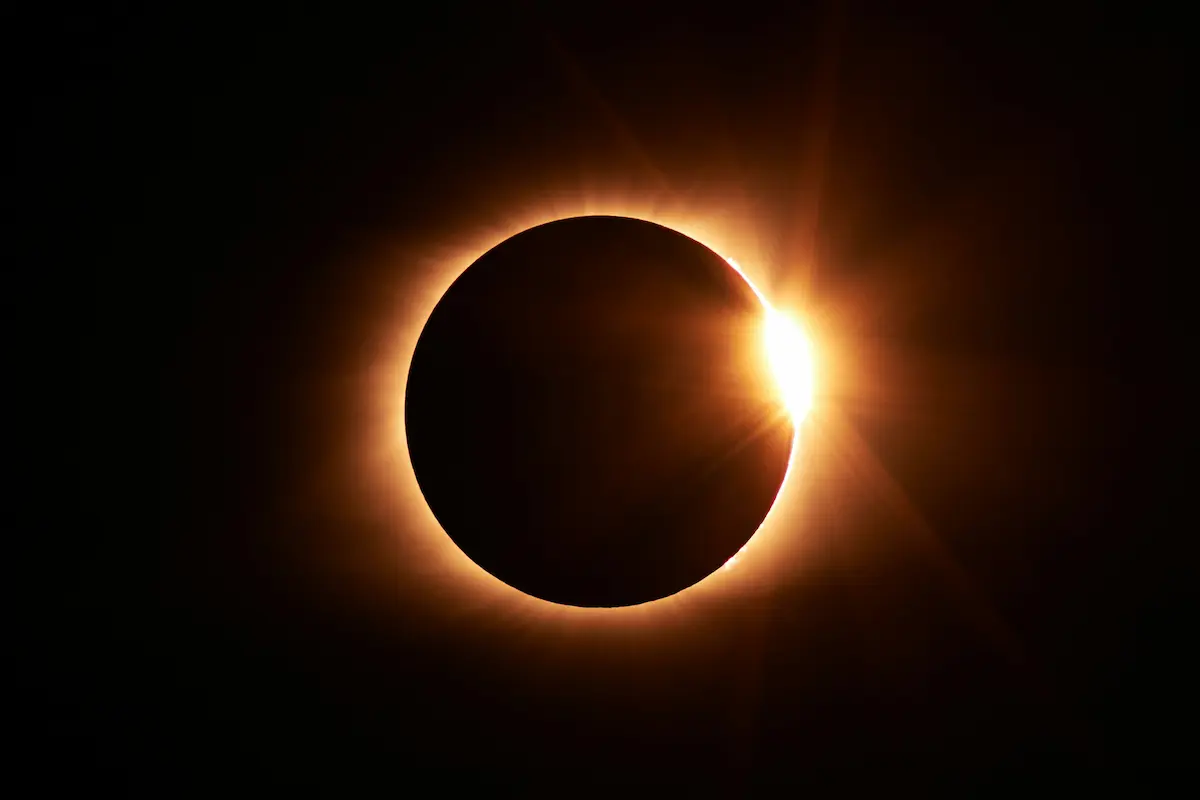
Why don’t we get eclipses every month?
The Sun, Earth, and Moon only line up exactly during special points in their orbits—called “nodes”—when the Moon crosses the ecliptic at just the right time. The odds are slim, so most months, no eclipse.
Solar eclipses occur only during the new moon, when the moon is between the Earth and the Sun. The Moon is in the middle, blocking sunlight from reaching the Earth.
Lunar eclipses occur only during the full moon, when the Earth is between the moon and the sun. Earth is in the middle blocking sunlight from reaching the Moon.
What Causes Eclipses? – NASA Space Place

The Phases of the Moon: A Cycle of Shadows
The Moon’s phases are just changing views of its sunlit half as it orbits Earth:
New Moon: Moon is between Earth and Sun—side facing us is dark.
Waxing Crescent/First Quarter: Increasing sunlight on the right (in the Northern Hemisphere).
Full Moon: Earth is between Sun and Moon—face we see is fully lit.
Waning Gibbous/Last Quarter: Sunlight shrinks from the right (again, Northern Hemisphere view).
Back to New Moon: The cycle repeats.
Why Does the “Shadow” Shrink and Grow During the Phases of the Moon?
The “shadow” on the Moon isn’t the Moon slipping into Earth’s shadow (that only happens during a lunar eclipse). Most of the time, it’s simply the unlit half of the Moon—the side not facing the Sun.
Here’s what’s really going on:
- The Moon is always half-lit by the Sun.
Just like Earth, at any moment, half the Moon is in daylight and half in darkness. - The phases we see depend on our angle.
As the Moon orbits Earth, we see different portions of its lit side. - New Moon:
The Moon is between Earth and the Sun. The lit half is facing away from us, so we see only the dark half—a “new moon.” - Waxing Crescent/First Quarter: ["waxing" means "increasing"]
As the Moon moves around Earth, we begin to see a sliver (crescent) of the lit side. With each night, more of the sunlit half comes into view—the shadow “shrinks.” - Full Moon:
Earth is between the Sun and Moon. Now, we see the entire sunlit side—the shadow is gone from our perspective. - Waning: ["waning" means "decreasing"]
After full moon, the process reverses. Less of the lit side is visible each night—the shadow “grows” again—until we’re back to new moon.
Key Point:
The “shrinking and growing shadow” is just the changing angle between the Earth, Moon, and Sun as the Moon orbits us. It’s not a real shadow crossing the Moon, but simply the line (the terminator) where sunlight stops.
Northern vs. Southern Hemisphere:
The sequence is the same, but the “lit” portion appears reversed. In the Northern Hemisphere, the right side lights up first; in the Southern, it’s the left. (So, Australians see their moon “backwards” compared to New Yorkers.)
The Tidally Locked Moon: No Permanent “Dark Side”
The Moon is tidally locked to Earth—it spins on its axis once every orbit around Earth (about 27.3 days). This is why we always see the same face.
No “dark side”: All parts of the Moon get sunlight. The far side is only “dark” to us, not in reality. Like the Earth, the Moon is illuminated over half of its surface at any point of the day. When we see the moon between the New and Full phase or vice versa, we are seeing a sliver of the daylight side, while the rest of the daylight side is invisible to us because it is on the other side of the Moon.
One lunar day = one month: It takes about 29.5 Earth days for the Moon to go from new moon to new moon and to revolve one time on its axis.
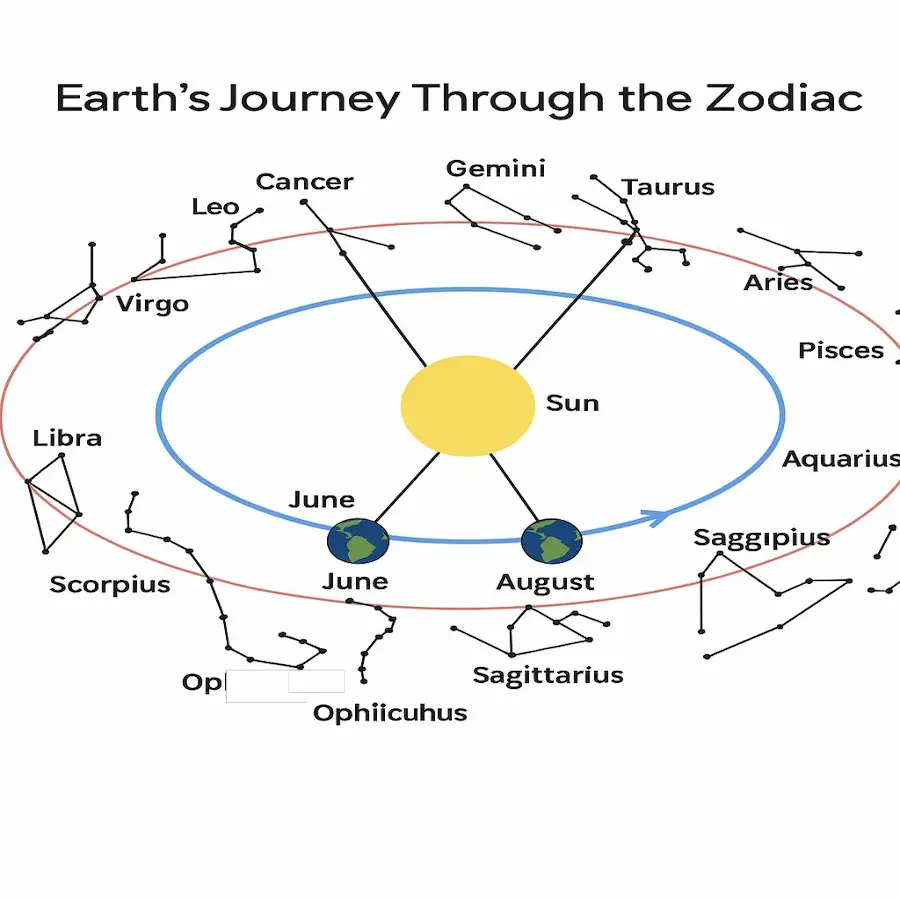
The Zodiac and the Night Sky: Constellations on the Ecliptic…and Off It
As Earth orbits the Sun, different zodiac constellations appear in the night sky at different times.
At any given moment, 360 degrees’ worth of constellations encircle the Earth—but we only see half of them. The other half are lost in the glare of the daylight sky. The twelve zodiac constellations trace the ecliptic, the Sun’s apparent path over the year. They’re visible only when Earth is positioned between the Sun and that constellation.
If the Sun sits between Earth and the constellation instead, it’s hidden in broad daylight, washed out by the Sun’s brightness. This is why, even though each constellation is technically present all year long, it seems to make a brief annual appearance—vanishing again until Earth’s orbit brings it back into the night sky.
Stars not on the ecliptic:
Some stars, like Polaris (the North Star) or the Southern Cross, are never on the Sun’s annual path. Instead, they sit near the celestial poles and are visible all year round from certain latitudes.
Northern Hemisphere: Polaris remains fixed in the north, always above the horizon if you live north of the equator, and cannot be seen from anywhere in the southern hemisphere south of about .7 degrees south of the Equator.
Southern Hemisphere: The Southern Cross never rises for most of the north, but circles the southern sky for much of the southern hemisphere. The Southern Cross can be seen in the southern portions of the United States, like portions of Texas and Florida, but north of that it is always invisible, being blocked by the curvature of the Earth.
Hemispheres affect your view:
In the north, some stars never set (circumpolar stars).
In the south, different circumpolar stars are visible, and many northern favorites never rise.
FAQ
Why don’t we get eclipses every month?
Because the Moon’s orbit is tilted about 5° to Earth’s orbital plane (the ecliptic). Most months the alignment at the nodes doesn’t line up, so no eclipse.
What actually causes the phases of the Moon?
We see different portions of the Moon’s sunlit half as it orbits Earth. The changing viewing angle—not Earth’s shadow—creates the phases.
What causes the seasons?
Earth’s 23.5° axial tilt changes both the Sun’s angle and day length over the year, giving each hemisphere summer and winter in turn.
Why does the Moon look “flipped” in the Southern Hemisphere?
Viewpoint. Observers in the Southern Hemisphere see the Moon from the opposite orientation, so the illuminated portion appears reversed.
Constellations – NASA Space Place




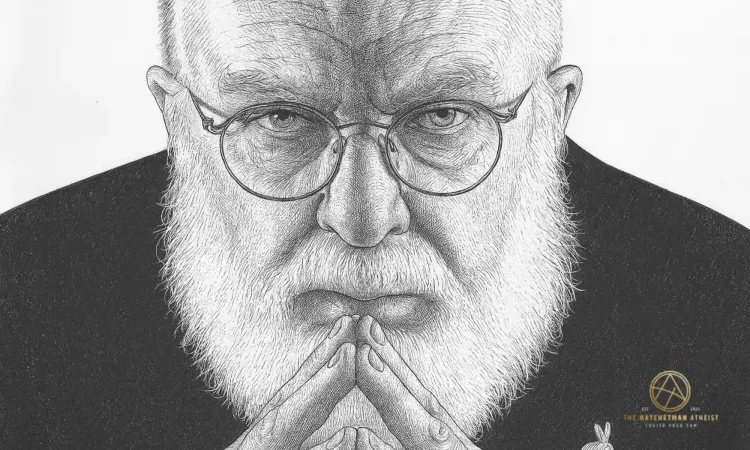
Comments ()